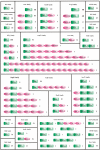cTFbase: a database for comparative genomics of transcription factors in cyanobacteria
- PMID: 17439663
- PMCID: PMC1858693
- DOI: 10.1186/1471-2164-8-104
cTFbase: a database for comparative genomics of transcription factors in cyanobacteria
Abstract
Background: Comprehensive identification and classification of the transcription factors (TFs) in a given genome is an important aspect in understanding transcriptional regulatory networks of a specific organism. Cyanobacteria are an ancient group of gram-negative bacteria with strong variation in genome size ranging from about 1.6 to 9.1 Mb and little is known about their TF repertoires. Therefore, we constructed the cTFbase database to classify and analyze all the putative TFs in cyanobacterial genomes, followed by genome-wide comparative analysis.
Description: In the current release, cTFbase contains 1288 putative TFs identified from 21 fully sequenced cyanobacterial genomes. Through its user-friendly interactive interface, users can employ various criteria to retrieve all TF sequences and their detailed annotation information, including sequence features, domain architecture and sequence similarity against the linked databases. Furthermore, cTFbase provides phylogenetic trees of individual TF family, multiple sequence alignments of the DNA-binding domains and ortholog identification from any selected genomes. Comparative analysis revealed great variability of the TF sequences in cyanobacterial genomes. The high variance on the gene number and domain organization would be related to their diverse biological functions and their adaptation to various environmental conditions.
Conclusion: cTFbase provides a centralized warehouse for comparative analysis of putative TFs in cyanobacterial genomes. The availability of such an extensive database would be of great interest for the community of researchers working on TFs or transcriptional regulatory networks in cyanobacteria. cTFbase can be freely accessible at http://cegwz.com/ and will be continuously updated when the newly sequenced cyanobacterial genomes are available.
Figures



Similar articles
-
Cyanobacterial KnowledgeBase (CKB), a Compendium of Cyanobacterial Genomes and Proteomes.PLoS One. 2015 Aug 25;10(8):e0136262. doi: 10.1371/journal.pone.0136262. eCollection 2015. PLoS One. 2015. PMID: 26305368 Free PMC article.
-
ArchaeaTF: an integrated database of putative transcription factors in Archaea.Genomics. 2008 Jan;91(1):102-7. doi: 10.1016/j.ygeno.2007.09.007. Epub 2007 Nov 26. Genomics. 2008. PMID: 18035520
-
TOBFAC: the database of tobacco transcription factors.BMC Bioinformatics. 2008 Jan 25;9:53. doi: 10.1186/1471-2105-9-53. BMC Bioinformatics. 2008. PMID: 18221524 Free PMC article.
-
Genomic repertoires of DNA-binding transcription factors across the tree of life.Nucleic Acids Res. 2010 Nov;38(21):7364-77. doi: 10.1093/nar/gkq617. Epub 2010 Jul 30. Nucleic Acids Res. 2010. PMID: 20675356 Free PMC article. Review.
-
Trends in Free-access Genomic Data Accelerate Advances in Cyanobacteria Taxonomy.J Phycol. 2021 Oct;57(5):1392-1402. doi: 10.1111/jpy.13200. Epub 2021 Aug 30. J Phycol. 2021. PMID: 34291461 Review.
Cited by
-
Genomic structure of an economically important cyanobacterium, Arthrospira (Spirulina) platensis NIES-39.DNA Res. 2010 Apr;17(2):85-103. doi: 10.1093/dnares/dsq004. Epub 2010 Mar 4. DNA Res. 2010. PMID: 20203057 Free PMC article.
-
The repertoire and evolution of ATP-binding cassette systems in Synechococcus and Prochlorococcus.J Mol Evol. 2009 Oct;69(4):300-10. doi: 10.1007/s00239-009-9259-9. Epub 2009 Sep 16. J Mol Evol. 2009. PMID: 19756840
-
Lineage-specific domain fusion in the evolution of purine nucleotide cyclases in cyanobacteria.J Mol Evol. 2008 Jul;67(1):85-94. doi: 10.1007/s00239-008-9127-z. Epub 2008 Jun 13. J Mol Evol. 2008. PMID: 18551331
-
Transcription factors in microalgae: genome-wide prediction and comparative analysis.BMC Genomics. 2016 Apr 11;17:282. doi: 10.1186/s12864-016-2610-9. BMC Genomics. 2016. PMID: 27067009 Free PMC article.
-
Cyanobacterial KnowledgeBase (CKB), a Compendium of Cyanobacterial Genomes and Proteomes.PLoS One. 2015 Aug 25;10(8):e0136262. doi: 10.1371/journal.pone.0136262. eCollection 2015. PLoS One. 2015. PMID: 26305368 Free PMC article.
References
-
- Brune I, Brinkrolf K, Kalinowski J, Puhler A, Tauch A. The individual and common repertoire of DNA-binding transcriptional regulators of Corynebacterium glutamicum, Corynebacterium efficiens, Corynebacterium diphtheriae and Corynebacterium jeikeium deduced from the complete genome sequences. BMC Genomics. 2005;6:86. doi: 10.1186/1471-2164-6-86. - DOI - PMC - PubMed
Publication types
MeSH terms
Substances
LinkOut - more resources
Full Text Sources
Miscellaneous

